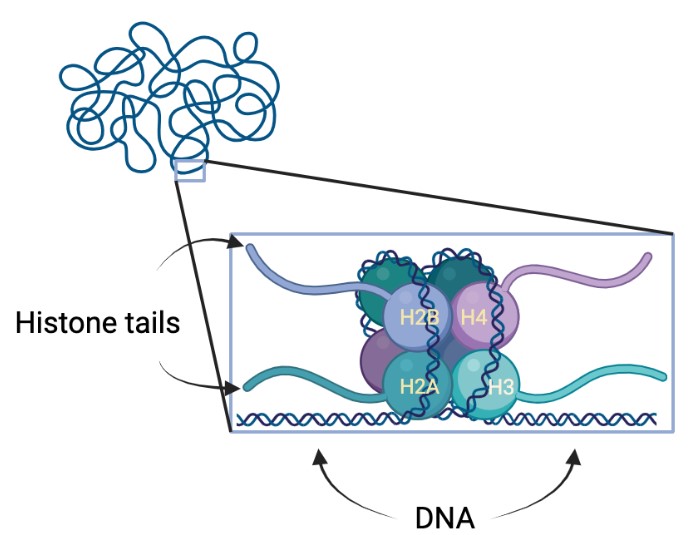Chromatin: Unraveling the Genome

Published on February 27, 2024
Yes, yes, humans have 46 chromosomes, yada yada yada. But have you ever wondered what makes up these chromosomes themselves? After loads of research, we today know this component as chromatin, a mixture of proteins and DNA with a multitude of functions. The concept of chromatin was first introduced in the late 19th century when researchers observed the granular structure of cell nuclei, paving the way for subsequent explorations. In the mid-20th century, the discovery of DNA's double helix structure by Watson and Crick set the stage for understanding how genetic information is stored. The identification of histones as the proteins around which DNA winds, forming nucleosomes, followed, bringing a pivotal understanding of chromatin's structural foundation. Advancements in microscopy and molecular techniques in recent decades have allowed scientists to delve into the dynamic nature of chromatin, uncovering its role in gene expression and epigenetic modifications.
Chromatin structure serves as a foundation of genetic information within the cell nucleus, providing an intricate framework for the orchestration of various cellular processes. At its most fundamental level, chromatin consists of DNA molecules tightly wound around histone proteins, forming nucleosomes. These nucleosomes, resembling beads on a string, not only compact the lengthy DNA strands but also play a crucial role in regulating access to genetic information. The histone octamer, composed of two copies each of histones H2A, H2B, H3, and H4, acts as a scaffold around which DNA is wound. This organized assembly forms the basis of chromatin, allowing the cell to efficiently package and store its genetic material. Beyond the nucleosome, chromatin's structural complexity extends to higher-order configurations, such as the 30-nanometer fiber and chromatin loops, contributing to the three-dimensional organization of the genome. Here’s a quick visual that puts these pieces together:

Understanding chromatin structure is pivotal, as it directly influences gene expression. Open chromatin regions are more accessible to cellular machinery, facilitating gene transcription, while closed chromatin restricts access, repressing gene activity. Thus, the nuanced architecture of chromatin serves as a dynamic regulatory platform, influencing cellular functions and playing a vital role in the broader landscape of genetics and epigenetics. Chromatin exists in diverse states, each reflecting distinct levels of compaction and accessibility, crucial for the regulation of gene expression. The two primary types of chromatin are euchromatin and heterochromatin, distinguished by their structural characteristics and functional roles.
Euchromatin, often referred to as the "open" chromatin, is loosely packed and transcriptionally active. It harbors actively transcribed genes, allowing regulatory proteins and RNA polymerase to easily access the DNA. Euchromatin is associated with dynamic cellular processes such as growth, development, and differentiation. Its relaxed structure facilitates the availability of genetic information for transcription, making it a pivotal player in cellular activities.
On the other hand, heterochromatin, known as "closed" chromatin, is densely packed and generally transcriptionally inactive. This condensed state restricts access to the underlying DNA, suppressing gene expression.
Heterochromatin is further categorized into constitutive and facultative heterochromatin. Constitutive heterochromatin contains repetitive DNA sequences and is consistently condensed, while facultative heterochromatin can transition between open and closed states, responding to developmental cues or cellular requirements. The key differentiator between euchromatin and heterochromatin lies in their compaction levels and transcriptional activity, with euchromatin being permissive for gene expression and heterochromatin associated with gene silencing and maintenance of genomic integrity. This intricate balance between these chromatin states plays a pivotal role in shaping the cellular landscape and orchestrating the complexity of gene regulation.
Okay BioCasters, so why do we care?
Since chromatin maintains cellular homeostasis and is intimately linked to both health and disease, the regulation of gene expression carried out by chromatin structure is essential for normal cellular functions and development. Chromatin ensures the precise execution of genetic programs, contributing to cell differentiation, tissue development, and overall organismal well-being (keeping you healthy, yay!). Proper chromatin structure is essential for maintaining genomic stability, as it helps prevent errors in DNA replication and repair. Additionally, the dynamic modulation of chromatin allows cells to adapt to changing environments and respond to external signals, ensuring that biological processes remain effective. Conversely, disruptions in chromatin architecture are implicated in many diseases. Chromatin abnormalities can lead to aberrant gene expression patterns, contributing to the development of cancer, neurodegenerative disorders, and various genetic syndromes. Among these abnormalities are epigenetic modifications, such as DNA methylation and histone acetylation, which can act as drivers of disease progression by silencing tumor suppressor genes or activating oncogenes (which are genes that induce cancer).
In research today, understanding chromatin’s role in disease is opening new avenues for therapeutic interventions. Targeting chromatin-modifying enzymes or using epigenetic therapies holds promise for precision medicine approaches, offering potential treatments for conditions where chromatin dysregulation plays a central role. In other words, by understanding how exactly chromatin’s structure interacts with other genetic components (which is much of Episode 5’s guest, Dr. Luger’s, work), we can really make an impact on finding ways to prevent and treat a myriad of genetic disorders. Thanks for reading everyone, and hope you learned something new about chromatin! As always, stay curious!
See you next time,
Parth and Chinmay